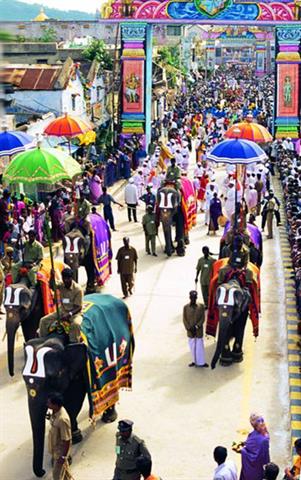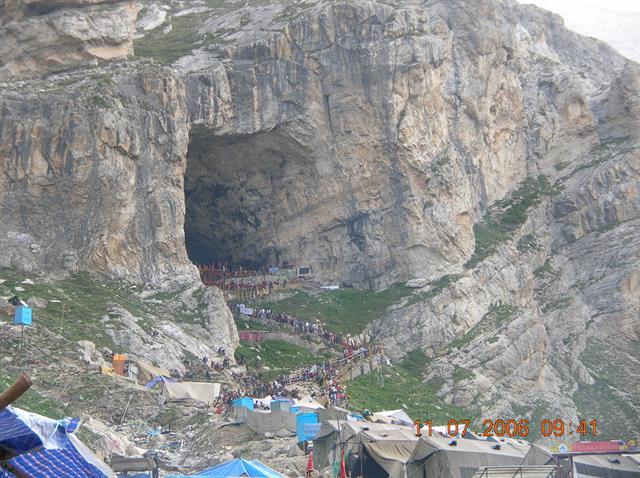YATRA (PILGRIMAGE) IN HINDUISM
Contents
- What is a Yatra?
- Yatra and its Association with Hindu Scriptures
- The Concept of Tirth Yatra
- Sacred Hindu Yatras
- Kanwar Yatra
- Kashi Yatra
- Kashi-Rameshwaram Yatra
- Kailash Mansarovar Yatra
- Amarnath Yatra
- Pandharpur Yatra
- Ratha Yatra
- Deoghar Yatra
- Char Dham Yatra
- 84 Kosi Parikrama
- References
What is a Yatra?
It is for self-purification and increasing one’s proximity with the Lord that one should go on a pilgrimage. The terms ‘jatra’ and ‘zatra’ are derived from ‘yatra’. Yatra is an important part of Hindu ritual, and many annual yatras in India are specially organized by the government to maintain their registrations, stipulating numbers, regulating their traffic, arranging food and lodging and other safety measures. As per Hindu tradition, it is desirable to perform yatra to various Hindu places, however it is not mandatory and hence yatra belongs to Kamya ritual.

Yatra and its Association with Hindu Scriptures
In the Hindu religion, a pilgrimage site is the one that oozes with spiritual and religious vibrations, special powers, knowledge and even miraculous capacities. In India, the confluence of sacred rivers, places linked to Puranic stories like Samudra manthan (churning of the great ocean) and Hindu legends like Mahabharata and Ramayana have now become most visited pilgrimages.
In many Hindu scriptures like Rigveda (1500 BC) wanderers are tremendously praised. Various other epics of the later age including Mahabharata (300 BC - 300 AD), Puranas (300 BC – 750 AD) and many vernacular scriptures have also mentioned particular sites that grant boons including sound health, wealth, prosperity, progeny, and moksha (salvation). Religious scriptures also guide Hindus to perform the last rites of the deceased kin in a pilgrimage site.

The Concept of Tirth Yatra
Pilgrimages which are performed collectively in a group are called tirtha yatras. As mentioned in our Hindu Dharma Shastra, a tirth yatra is generally executed bare footed without vehicles or comforts. The concept of tirth yatra is mentioned in many scriptures like Skhanda Purana, Sthala Purana, Maha Bhagavatha, Sri Venkatachala Mahatmiya, Maha Bharatha, Brahma Purana, Matsya Purana, and Brahmanda Purana.
As mentioned in Sthala Purana, great sages in the ancient days specially used to perform tapas (meditation) and other spiritual activities in these sacred tirth places. Hence, these sites are guided by spiritual forces that can wipe out one’s evil tendencies and take him towards the path gyan (knowledge), bhakti (devotion) and self-realization.
Sacred Hindu Yatras
Some of the famous Hindu pilgrimages are discussed as below –
Kanwar Yatra –

This yatra is performed during the most sacred month of Hindu calendar i.e. Shraavan Maas (July-August). Millions of devotees of Lord Shiva known as Kanwarias visit holy places like Gangotri, Haridwar and Gaumukh in the state of Uttrakhand.
Kashi Yatra –
Thousands of people visit the holy town of Kashi (present Varanasi or Banares) to conduct Vedic rites for their ancestors. Located in the state of Uttar Pradesh, Kashi is considered the epitome of Hindu religion as innumerable parikramas take place here throughout the year. Various religious rituals are also performed here to help one attaining nirvana (salvation). It is also believed that those who take their last breath in the land of Kashi attain freedom from the gruelling cycle of life and death.

Kashi-Rameshwaram Yatra –
There is a link between Kashi and Rameshwaram yatra. Rameshwaram is a holy place located in the South Indian state of Tamil Nadu. As mentioned in ancient scriptures like Skanda Purana, rituals performed in Kashi bear best results when performed as per the ancient religious standards. It is extremely auspicious if a devotee performs Saikatha puja at Rameshwaram, collects some sand from the same place and travels all the way through Kashi to immerse it in the holy Triveni Sangam where the River Ganga, Yamuna and Saraswati converge. At the same time, it is also fortunate if one, after propitiating Lord Shiva at Kashi Vishvanath Temple in Banares, brings the holy water from the Ganges to the Rameshwaram Temple to offer Abhisheka to the Jyothirlinga of Lord Shiva present, here in the form of Lord Ramanathaswamy.
Kailash Mansarovar Yatra –
Situated in the Himalayan region of Tibet at the height of 6,740 m, Mount Kailash is a famous pilgrimage in Hinduism, Jainism, Tibetan Buddhism and Bonpo (followers of Bon tradition). In Hindu religion, Mount Kailash is revered as the earthly manifestation of Mount Meru. Mount Kailash is the spiritual and religious hub of the Hindus as it is believed that Lord Shiva resides at the peak of the mountain along with his beloved wife Parvati. The roots of the mountain is considered hell while the peaks are the spiritual abode of Lord Shiva and hence considered heaven.
Amarnath Yatra –
It is one of the holiest pilgrimage centres and the prime deity in the Amarnath cave is Lord Shiva. Amarnath is located around 88ml from Jammu and Kashmir at the altitude of 12,756 feet. Lord Shiva is propitiated here in the form of a self-manifested Jyotirlinga. An ice lingam is formed every year along with two other formations of Parvati and Lord Ganesha. Pilgrims in lakhs visit this holy abode of Shiva and the temple is considered one of the most popular yatra destinations of the Hindus. The cave is opened for the pilgrims only during the summer and the rest of the year the cave is covered with snow-capped mountain.

Pandharpur Yatra –
Pandharpur Yatra is one of the most famous yatras of Maharashtra, India. There is tremendous significance of this festival amongst Marathis because of its Palkhi festival to revere and commemorate famous saints that lived in different parts of Maharashtra at one point of time. These saints are Sant Dyaneshwar (Alandi), Sant Tukaram (Dehu), Eknath (Paithan), and Nivruttinath (Trimbakeshwar). Thousands of devotees visit Pandharpur during this festival and they all carry palkhis of these saints as part of the ritual. The festival is specifically organised and celebrated by Warkaris who are worshippers of Lord Vishnu’s incarnation Vithoba.
Ratha Yatra –
This festival is held every year at Puri in Orissa, India. Ratha Yatra generally falls in the months of June-July and is celebrated on Sukla Paksha of Ashad month. The 15 day celebration begins on the day of Akshay Trtiya. It is called the festival of chariots and is celebrated during the grand event when Lord Jagannatha, along with his brother Balarama and sister Subhadra, visit the Gundecha temple, few miles away in the north. Pulling the vamana or chariot with ropes is considered extremely sacred, on the other hand merely getting the sight (darshan) of vamana is also considered extremely lucky.
Deoghar Yatra –
Baidyanath Temple, one of the twelve Jyotirlingas, is located at Deoghar, in eastern Jharkhand. The place is also famously called Baidyanath Dham or Baba Dham. Deoghar literally means spiritual abode of various gods and goddesses. There is a tradition of carrying holy water of River Ganga from Sulanganj and offer it to Baidyanath Jyotirlinga. The yatra takes place during the Hindu month of Shraavan and Kanwariya (pilgrims), reciting Bam Bam Bhole japa, walk around 109 km to the temple. Throughout the month of Shraavan, the Shravani Mela takes place in the town of Deoghar around the Baidyanath Temple vicinity with utmost zeal and zest.
Char Dham Yatra –

Char Dham (Four pilgrimage sites) are extremely revered sites that are visited by Hindus from all across the world, in bulk. The Char Dham yatra sites are spread all across the country – Badrinath (North), Dwarka (West), Puri (East), and Rameshwaram (South). The four sites have been established as Hindu spiritual and sacred sites by Jagadguru Sri Adi Shankaracharya. As mentioned in Hindu Scriptures, those Hindus who could visit Char Dham once in their lifetime initiate their progress towards salvation.
84 Kosi Parikrama –
Since thousands of years, the 84-Kosi Yatra has borne tremendous significance in the Hindu religion. It is said that this yatra gives its performer freedom from 84 lakh Yoni. The month of Chaitra (February-March) is most suitable for 84-Kosi Yatra. The ritual includes circumnavigation of seven districts of Uttar Pradesh. During Treta Yug, the King of Ayodhya successfully completed his yagna (fire sacrifice) here at Makhurha, District Basti, Uttar Pradesh. Hence, a group of religious scholars also opine that rather than Ayodhya, this yatra should start off from the Basti district itself.
http://www.britannica.com/EBchecked/topic/266312/Hinduism/261634/Pilgrimage
http://en.wikipedia.org/wiki/Yatra
http://chardham.euttaranchal.com/importance-of-chardham.php
https://in.answers.yahoo.com/question/index?qid=20111111030455AA450ok
http://qna.rediff.com/questions-and-answers/what-is-the-meaning-of-tirtha-yatra-what-are-the/15895793/answers/15895803
View/s: 4848 Comment/s: 0
